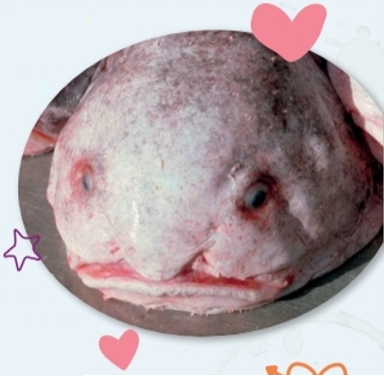THINK! Look at the animals in the box. Which animals do you think are ugly?
(Hãy nghĩ xem! Nhìn những động vật trong khung. Động vật nào em nghĩ xấu xí?)
|
eagle gorilla frog spider bat crocodile |

– eagle: đại bàng
– gorilla: khỉ đột
– frog: ếch
– spider: nhện
– bat: dơi
– crocodile: cá sấu

I think none of the animals is ugly because each animal has its own natural beauty.
(Tôi nghĩ không có động vật nào xấu xí cả vì mỗi loài động vật có vẻ đẹp tự nhiên riêng của nó.)
Exercise 1. Check the meanings of the words in blue in sentences 1-3. Then read the text. Which sentences does the writer agree with?
(Kiểm tra nghĩa của những từ màu xanh trong câu 1-3. Sau đó đọc văn bản. Tác giả đồng tình với câu nào?)

1. It’s important to protect all animals because they are all interesting.
2. It’s best to protect the beautiful species, not the ugly ones.
3. A lot of species become extinct every year. Animals in danger need our help.
BLOBFISH we love you!
The blobfish isn’t the most beautiful or common fish on the planet. It has a dull colour and you don’t usually see it because it lives 1,000 metres under the seas near Australia.
But now through magazines and the internet, the blobfish is famous because people say that it’s the ugliest animal in the world.
Every year, thousands of species of animals become extinct. We often see information about the biggest, the most interesting, the most beautiful and the most colourful, such as whales, butterflies or pandas. The weirdest or ugliest animals also need our help.
Are they really ugly? No, they’re interesting and rare. The best idea is to protect all animals.
Advertisements (Quảng cáo)
Tạm dịch bài đọc:
BLOBFISH chúng tôi yêu bạn!
Cá blobfish không phải là loài cá đẹp nhất hoặc phổ biến nhất trên hành tinh. Nó có màu sắc xỉn và bạn thường không nhìn thấy vì nó sống sâu 1.000 mét dưới vùng biển gần nước Úc.
Nhưng bây giờ thông qua các tạp chí và Internet, cá blobfish nổi tiếng vì mọi người cho rằng nó là loài động vật xấu xí nhất trên thế giới.
Mỗi năm, hàng nghìn loài động vật bị tuyệt chủng. Chúng ta thường thấy thông tin về những con lớn nhất, thú vị nhất, đẹp nhất và nhiều màu sắc nhất, chẳng hạn như cá voi, bướm hoặc gấu trúc. Những con vật kỳ lạ nhất hoặc xấu xí nhất cũng cần sự giúp đỡ của chúng ta.
Chúng có thực sự xấu xí? Không, chúng thú vị và quý hiếm. Ý tưởng tốt nhất là bảo vệ tất cả các loài động vật.

1. It’s important to protect all animals because they are all interesting.
( Điều quan trọng là phải bảo vệ tất cả các loài động vật vì chúng đều thú vị.)
2. It’s best to protect the beautiful species, not the ugly ones.
( Tốt nhất hãy bảo vệ những loài đẹp đẽ chứ không phải những loài xấu xí.)
3. A lot of species become extinct every year. Animals in danger need our help.
( Rất nhiều loài bị tuyệt chủng hàng năm. Động vật đang gặp nguy hiểm cần sự giúp đỡ của chúng ta.)

Advertisements (Quảng cáo)
– protect (v): bảo vệ
– species (n): loài
– become extinct: trở nên tuyệt chủng/ bị tuyệt chủng
– danger (n): sự nguy hiểm
– help (n): sự giúp đỡ
The writer agrees with the sentences 1 and 3.
(Tá giả đồng tình với câu 1 và 3.)
Exercise 2. Read and listen to the text and write True or False.
(Đọc và nghe văn bản và viết Đúng hoặc Sai.)
1. The blobfish is quite rare.
2. The blobfish sometimes lives in rivers.
3. The blobfish is well-known through magazines and the internet
4. There’s a lot of information about pandas, but not whales.

|
1. True |
2. False |
3. True |
4. False |
1. True
(Cá blobfish khá hiếm. => Đúng)
2. False (It lives 1,000 metres under the sea.)
( Cá blobfish đôi khi sống ở sông. => Sai: Nó sống ở đáy đại dương sâu 1000 mét.)
3. True
(Cá blobfish được nhiều người biết đến qua các tạp chí và internet. => Đúng)
4. False (We often see information.)
(Có rất nhiều thông tin về gấu trúc, nhưng không phải cá voi. => Sai: Chúng ta thường thấy thông tin.)
Exercise 3. VOCABULARY PLUS Use a dictionary to check the meanings of the words in blue in the text.
(Từ vựng bổ sung. Sử dụng từ điển để kiểm tra nghĩa của các từ màu xanh trong văn bản.)

– beautiful (a): xinh đẹp
– common (a): phổ biến
– dull (a): tối (màu)
– colourful (a): màu sắc
– rare (a): khan hiếm/ quý hiếm
Exercise 4. USE IT! Work in pairs. Do you know the names of any animals in danger? Do you think which ones are ugly and which ones are beautiful?
(Thực hành! Làm việc theo cặp. Em có biết tên của các động vật có nguy cơ tuyệt chủng không? Em nghĩ động vật nào xấu xí và động vật nào xinh đẹp?)

Some endangered animals I know are panda, Sunda tiger, Amur leopard, black rhino, Cross River gorilla, Hawksbill turtle, orangutan, saola, Sumatran elephant. I think all of them are beautiful and cute, none of them are ugly.
(Một số loài động vật có nguy cơ tuyệt chủng mà tôi biết là gấu trúc, hổ Sunda, báo Amur, tê giác đen, khỉ đột sông Cross, rùa đồi mồi, đười ươi, sao la, voi Sumatra. Tôi nghĩ tất cả chúng đều đẹp và dễ thương, không có con nào xấu cả.)

